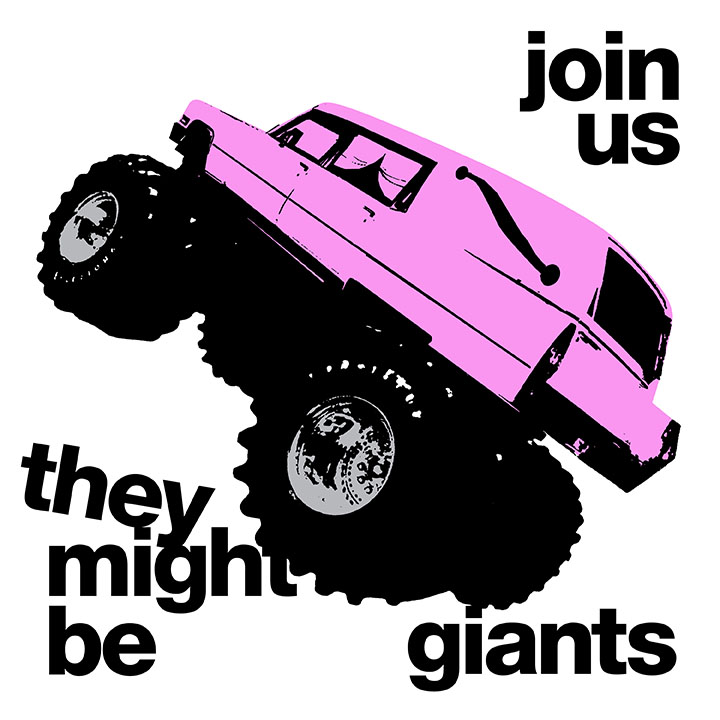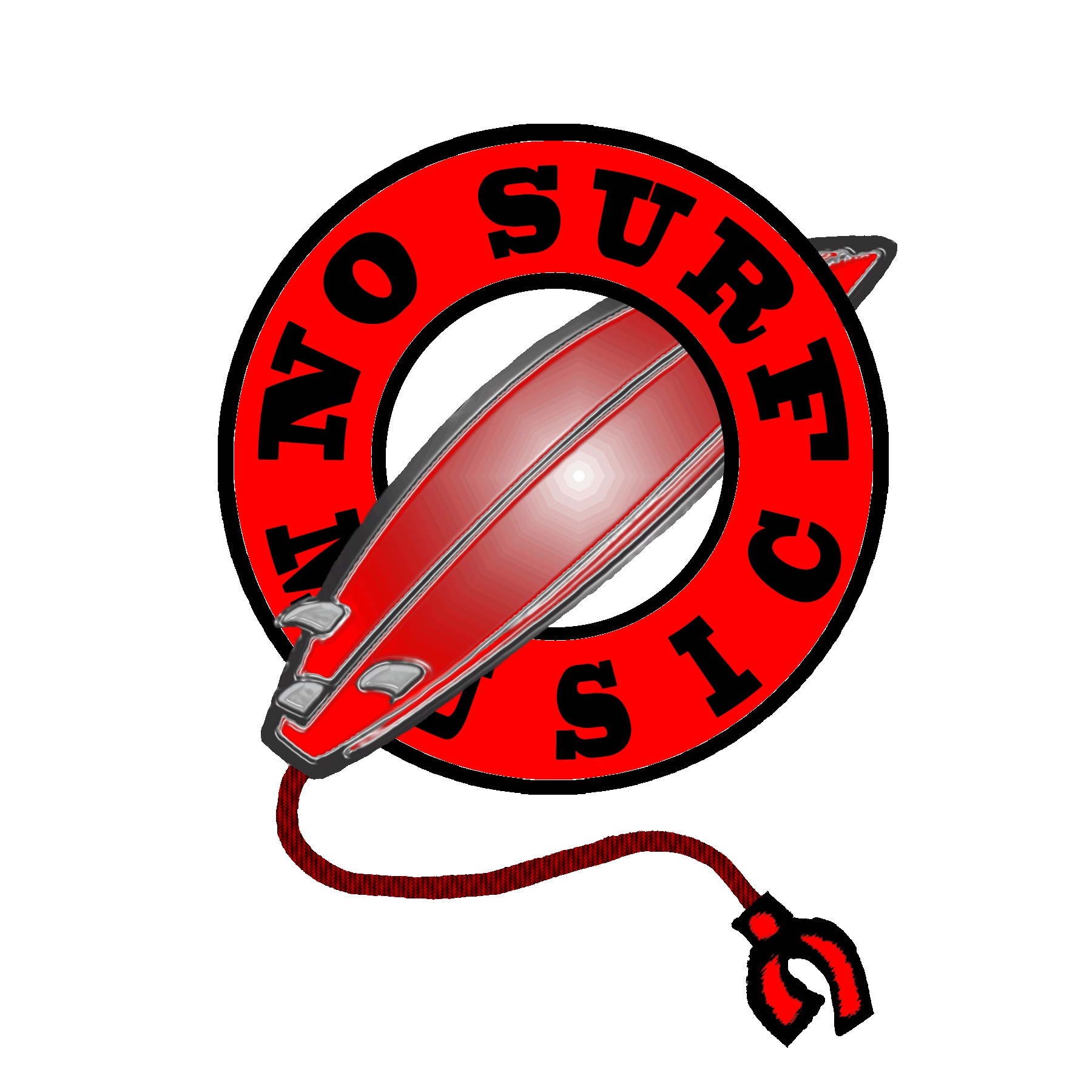
The Lowdown:
July 19, 2011
They Might Be Giants: Join Us
by Jason D. 'Diesel' Hamad
The two Johns that form the crazy-ass, genius core of They Might Be Giants. Linnell is on the left, Flansburgh on the right.
They Might Be Giants may seem a little out of the mainstream of this site, but remember our mantra: if we like it we’ll review it. And at No Surf we love TMBG.
Since forming They Might Be Giants in 1982, John Flansburgh and John Linnell have been waving the freak flag of geek rock proudly, producing songs that reference science, math, history, literature, pop icons, and often have no discernable literal meaning whatsoever. Whatever the subject, their lyrics are always marked by clever wordplay and a whimsical attitude that sets them apart from any other musical act. Even for people who don’t bother to deconstruct the lyrics, the band’s poppy brand of alternative music has wide appeal. John & John essentially played as a duo—Flansburgh on guitar and Linnell on accordion with a drum machine backing them—until 1994’s John Henry, when they finally incorporated a full band.
Since issuing their self-titled debut in 1986, They Might Be Giants has released more than a dozen albums, all with the same crazy spin on what music should be. They transform decidedly uncool into defiantly cool, making them a favorite of all sorts of nonconformists. They are never entirely serious—and often not at all serious—a quality that has endeared them a small legion of devoted fans, many of whom probably sang TMBG songs while waiting for the janitor to come by and let them out after being stuffed in their high school lockers. For many years they were popular on college campuses (they appeared on McDonough Field twice in my own 4-year tour at Emory), but as their longtime fans have grown older they’ve gradually gained a wider range of acceptance. With catchy (if crazy) songs like “Ana Ng,” “Birdhouse in Your Soul,” “Istanbul (Not Constantinople),” “The Statue Got Me High” and “Snail Shell” they’ve even managed to make the singles charts a few times, and several of their creative, low-budget videos saw heavy rotation on MTV in their time. They are responsible for the impossibly catchy theme song for The Daily Show with Jon Stewart and their song “Boss of Me” was the theme to the longtime hit comedy Malcolm in the Middle. They’ve even been featured in a series of Dunkin’ Donuts commercials.
Keeping with their geek personae, the Johns have often been early adapters of technology and have found interesting ways to get their music heard. They pioneered one of the craziest (and most cultishly popular) musical distribution schemes in history: Dial-a-Song, which was an answering machine set up in a Brooklyn apartment that played a different song every time a fan called (“Free when you call from work”). As technology progressed, they moved the service online, and then launched their own podcasts. TMBG.com was the first music website I ever visited, and it was well designed and graphically appealing long before most bands could even spell “www.” Way back in the dark ages of 1994 they began selling their own mp3’s online, even though it took about a week to download a track with a dial-up modem. Prior to that, the band’s 1992 album Apollo 18 was designed specifically to take advantage of CD players’ shuffle feature, and along with more traditional-length songs it contained a surfeit of snippets ranging from a few seconds on up that would combine in different configurations every time the disc was played. There’s no doubt these guys are always thinking a little outside the box and often ahead of their time.
Their fifteenth studio release, Join Us, doesn’t change the equation very much, although it seems to have a few more Prince impressions than one normally expects out of TMBG and John Linnell’s playful accordion—so prevalent in the early duo years—has long ago fallen victim to the full band sound. A return to “adult music” after several Grammy-winning releases geared specifically for children, it is filled with a plethora of short tracks (18 to be exact), some of which are more like fragmentary morsels rather than fully formed songs. Although this is not the group’s best release, it contains several gems and plenty of the whimsical spirit that has endeared They Might Be Giants to so many slightly off-color fans.
Unfortunately, the pure goofy joy of a TMBG album doesn’t translate particularly well on paper (or website), but it’s fair to give you an overview of the beautiful insanity that Join Us contains.
The best song on the album is “When Will You Die.” Frenetically paced and musically highlighted by a blazing guitar break and great syncopated horn parts, it is a happy-sounding song with beautifully sarcastic lyrics centered on the longed-for death of a especially vile acquaintance, possibly (although probably not) me:
You’re insane. You are bad.
You wreck everything you touch
And you’re a sociopath.
There’s just one thing that everyone’s wondering,
When will you die?
After the exposition, the song then breaks into a particularly vivid fantasy of the day when:
School children stay at home
And all the banks will close.
Each year we’ll mark the date
On which we celebrate.
I know how. I know why.
I can picture every part of your comeuppance
Except for the one remaining piece of the puzzle,
Which is when you’ll die.
The entire piece is filled with that great old TMBG whimsy that no other band on Earth has ever managed to copy. The video (above) features the construction and then (spoiler alert) spectacular destruction of a giant cardboard model of the pink monster truck hearse pictured on the album's cover.
The first single, “Can’t Keep Johnny Down,” starts the album out with a beautiful cascade of notes. It's surprisingly “normal” for a TMBG song, both musically, where it's a fairly straightforward rock tune, and thematically, theme of bouncing back from adversity and rebelling against work-a-day strife.
I'll number a million to one
All of the dicks in this dick town
Can't keep Johnny down.
Men piled up into towering mounds
None of them once has found a way
To keep Johnny down.
Spending days by myself
Remembering slights
I'm not a monument to justice
Plus which I don't forget a face.
And they can't,
Can't keep Johnny down.
They haven't yet built a man
That'll keep old Johnny down.
Just to make sure there's no forgetting it's a They Might Be Giants song, however, there is a reference to Alan Sheppard hitting golf balls on the moon and shitting in his space pants.
The song has not one, but two videos (anything worth doing is worth overdoing). The official version (above right) is a mini-movie featuring the one and only Rip Torn in a David vs. Goliath street-fighting scene (well, really a warehouse fighting scene... and David is an old man and Goliath is a wirey greaser with an inferiority complex. The second, slightly less-official video (right) is a "Memento"-like backward-tracking affair that includes just a little too much pudgy dude tighty whitey action for my taste. But whatever.
“2082” is a mind-bending story of a time traveler who goes to visit himself in the long-distant future and decides to play Dr. Kevorkian:
You must honor and respect the older fellow,
Even as you suffocate him with his pillow.
Though you’re strong, he was wise.
There is much you can learn from the sage
And though you’ll even travel back to your own age
You will meet again, you two,
In 2082.
Not exactly Arthur C. Clarke, but then Arty never could tell a good joke. Damn Brits are so stuffy.
In the great tradition of TMBG, “You Probably Get That a Lot” starts off with what may be the strangest pickup line ever uttered:
Do you mind?
Excuse me...
I saw you over there,
Can I just tell you,
Although there are millions of cephalophores that wander this world,
You’ve got something extra going on.
I think you know.
You probably get that a lot.
Now, we use a lot of big, strange words on this site (I did learn everything I know about obscure references from John & John, after all), but for those who don’t know, a cephalophore is a saint depicted as carrying his or her own head in hand, in order to signify that the person in question was martyred by beheading.
It’s the way you swing your head while strolling fancy free
Or melting down some army guys to make green tea.
As the headless horsemand said to his assoiate,
The bodiless baboonsman cradled in his arms,
Although millions of cephalaphores are marching past my door
They're invisible to me except for one cephalaphore.
You probably get that a lot.
Totally get the attraction. Sounds like the perfect girl to me. The song is built on a wildly fluctuating synthesizer with a driving drumbeat and a guitar that kicks into power chords to emphasize the chorus. As usual, it’s best to avoid looking for a literal meaning and just enjoy the weirdness that comes from the combined Johnbrain.
It's hard to imagine a simpler concept for a video than the one that accompanies this song (above right), but it's got a certain kind of chic coolness about it. Shot in stark black & white, it simply depicts the band performing the song in a wood-paneled studio. There's something about the lighting and the camera angle that make Linnell's eyes look particularly freaky as he looks into the fourth wall and sings, which adds an extra layer of crazed obsession to the lyrics.
“In Fact” starts with a bit of wailing sax that cuts into a lively beat occasionally accented by trumpet flourishes and ends in a distorted keyboard and flute frenzy. The lyrics don’t make a hell of a lot of sense—even by TMBG standards—but can best be summed up with this sample:
I confess I’m like a chess piece, yes.
I have rolled under your piano
That you don’t play a lot.
But I’m sorry, I digress.
I’m a mess.
With a terrific string of power chords and poppy background vocals, “Judy Is Your Viet Nam” paints the picture of a problematic relationship with an ambiguously troublemaking girl. It features several great lines, not the least of which are found in the closing series:
Judy lies but you believe her.
She’s the storm before the calm.
Judy is the great deceiver.
Judy is your Viet Nam.
“Cloisonné” features an insane jazzy vibe that sounds a little like Harry Nilsson’s “Coconut” and lyrics that seem to have been chosen exclusively for their sound rather than meaning. It features some great bass clarinet action by Linnell and some very coolly delivered vocals by Flansburgh. It, too comes with a video (right), very similar to the one for "You Probably Get That A Lot" but with a bit more of a paranoid tone, which is befitting. The black & white is not dunked in a bluish hugh, quick flash cuts almost attack the viewer like the devil's face in “The Exorcist” and the John's old friend William Allen White makes his triumphant return to stare at the band in cardboard stillness.
With a name like “Let Your Hair Hang Down” one might expect a David Crosbyesque political polemic, but instead, in this song the Johns seek answers to some of the more important questions in life:
Why do we resemble concrete?
Did we order all these rain clouds?
Who overturned the party cart?
Who said to stomp the fire out?
Let the wrong be wrong.
Would it be so bad
When your hair’s so long,
When you look so sad?
Let your hair hang down.
"Spoiler Alert" has a pretty interesting concept. It's two songs in one. Each of the Johns sings an essentially unrelated vocal track, often one over the other. But while the music plays on both sides of the stereo track, each of the vocals is limited to one. Thus, if you take out one headphone or turn your balence all the way in one direction, it's understandable. The problem is that while the concept is pretty cool, both songs are actually pretty forgettable. But whatever, it's still neat for the novelty factor. I suppose it was this dueling vocal thing that inspired them to lip-synch the song using their hands (Nude sock-puppet-synching. It used to be an Olympic sport way back in the day. Look it up. The Greeks did everything nude.) for the video (above right). Or at least I presume it's the Johns's own hands. I mean, they're not superstars, but I guess they could have used stunt doubles, like that chick who played Julia Robert's ass in “Pretty Woman”. If it is John and John themselves, then one thing's for sure: Linnell needs to trim his nails. Man, there are like a million nail places in Brooklyn. Just head down to Atlantic Mall.

The Johns: Still crazy after all these years. That's why we love 'em. Photo by Shervin Lainez.
Other songs of note include “Canajoharie”, alternately a lament for lost history and a story about a swamp monster attack, all apparently taking place in upstate New York and set upon a tapestry of rocking guitar riffs and a synth-pop feel. “Celebration” is a bit of funk fantasy about partying, with a bridge straight out of Prince’s purplest nightmares. “Dog Walker” includes strange chipmunk vocals and fuzzy bass and guitar lines that make it seem like another Prince… er… tribute. Sounding surprisingly like Robbie Fulks, “Protagonist” is a story told to a snapped-finger and clapped-hand beat, with a Greek-style chorus breaking in to describe the screen directions as the scene moves along and cooing background vocals lament the title character’s sad situation.
Join Us may not be as perfectly entertaining as They Might Be Giants, Lincoln or Factory Showroom (and I miss the accordion), but it nearly matches Flood or Apollo 18 and contains quite a bit of that crazy TMBG magic. Any longtime fan is sure to be happy. It’s amazing that John Flansburgh and John Linnell have been able to advertise their obvious insanity to the world for almost three decades without being forcibly committed, but let’s hope they keep themselves one step in front of the straightjacket for as long as they can, because if there’s one thing the world can always use a little more of, it’s the kind of beautiful, surreal, off-the-wall fun that they so cleverly produce.
| mp3 | cd |
|---|---|






